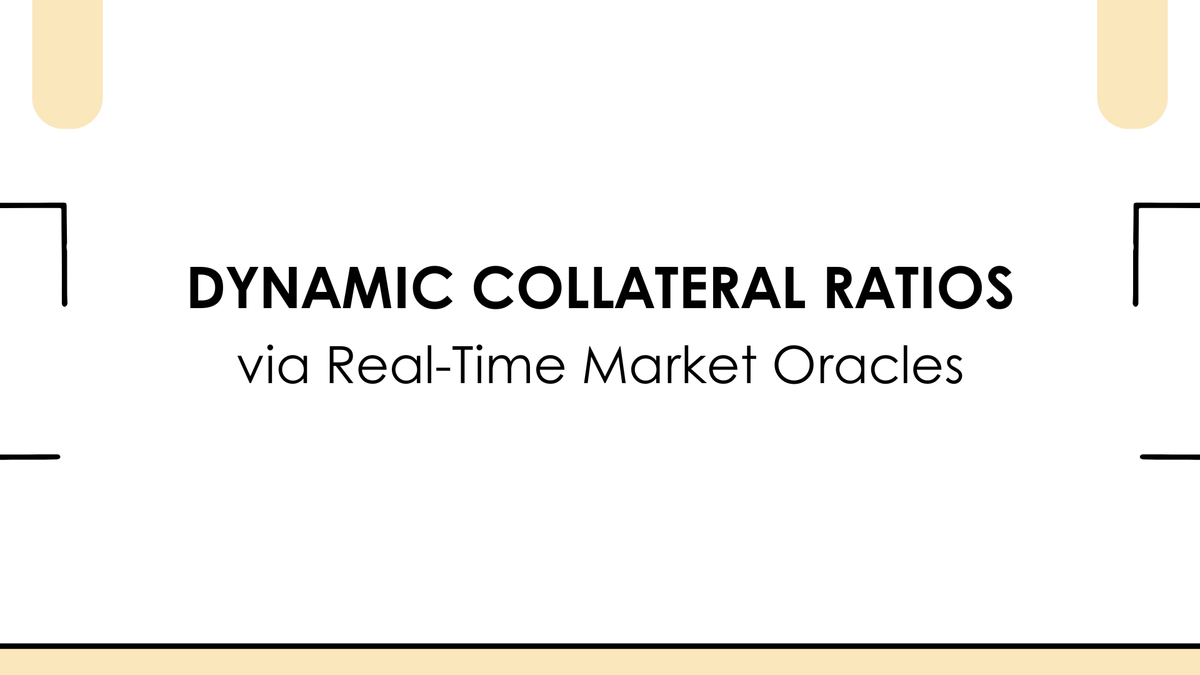Dynamic Collateral Ratios via Real-Time Market Oracles

Traditional systems often rely on fixed collateral ratios, forcing users to lock up substantial excess capital to guard against market swings. But with volatile asset prices, static over-collateralization can be inefficient, tying up capital that could otherwise be deployed. Real-time market oracles solve this dilemma by delivering continuous price updates from multiple venues, empowering protocols to auto-adjust collateral ratios on the fly. The result is optimized capital use, fewer liquidations in turbulent markets, and a more resilient DeFi ecosystem.
Oracles: The Data Bridge Between On-chain and Off-chain
Smart contracts are deterministic and isolated; they cannot fetch external data themselves. Oracles serve as the bridge, feeding real-world inputs (price feeds, interest rates, weather data) into on-chain logic. High-quality Oracle solutions share these traits:
- Decentralization: Data is aggregated across multiple node operators to prevent single points of failure.
- Security & Auditing: Node operations and data sources undergo rigorous security reviews.
- Data Quality: Feeds combine authenticated APIs, on-chain DEXes, and institutional venues to produce volume-weighted, outlier-resistant prices.
- Transparency & Verifiability: Historical updates and node reputations are publicly accessible on-chain.
Industry-leading implementations include:
- Chainlink Data Feeds: Secure, decentralized price oracles with premium market coverage.
- Pyth Network: Low-latency feeds sourced directly from exchanges and liquidity pools, delivering confidence intervals alongside prices.
- Orakl by Rhombus: On-chain oracle optimized for lending protocols, integrating multiple institutional venues for real-time asset valuation.
By continuously updating asset valuations, these oracles unlock dynamic collateral management previously impractical in a static, batch-oriented world.
From Static to Dynamic Collateral Ratios
Static Collateral Ratios
Most DeFi protocols today set a fixed collateral ratio (e.g., 150%). Users must deposit collateral worth at least 150% of their loan. While simple, this approach suffers from:
- Capital Inefficiency: Users over-collateralize to buffer against price swings, locking up more capital than necessary.
- Liquidation Risk: If collateral value drops faster than the protocol’s oracle refresh interval, positions become under-collateralized, triggering liquidations that may not reflect real market conditions.
Dynamic Collateral Ratios
Dynamic collateralization adapts the required ratio in real time based on market volatility and risk metrics. Key components include:
- Fair Price vs Market Price Ratio: Ratio = Market Price / Fair Price. It measures real-time deviation.
- Delta (Δ): A buffer quantity that adjusts with volatility: Δ = \-Δₘᵢₙ × ((1 – Tolerance)² / (1 – Ratio)² − 1)
- Dynamic Collateralization Ratio (Dynamic CR): Dynamic CR = Base CR − Δ
- Gamma (Γ): An additional buffer to prevent cascading liquidations by liquidating only part of a user’s position when Health < Γ.
These formulas, used by Ratio Finance’s Dynamic Risk Management, let protocols expand collateral margins under severe volatility while loosening them when markets stabilize.
Auto-Adjustment Workflow
- Data Acquisition: Oracles continuously fetch price data from DEXes, centralized exchanges, and institutional sources.
- Deviation Computation: Smart contracts compare the on-chain Market Price against a computed Fair Price (e.g., pool’s internal EMA).
- Buffer Calculation: Delta and Gamma values update in real time according to the deviation and pre-configured risk tolerances.
- Collateral Ratio Update: The protocol adjusts each vault’s required collateral ratio on-chain, reducing friction for borrowers and limiting liquidation overreach.
- Health Monitoring & Liquidation: A borrower’s Health = Collateral / Debt − Dynamic CR. If Health < Γ, partial liquidation occurs, protecting both the pool and the user from full position wipe-outs.
Protocol Case Studies
Ratio Finance
- Risk Ratings (RRR) assign each liquidity pool a risk grade (e.g., AA for USDT-USDC).
- Collateralization Ratios start at 110% for AA pools.
- Delta & Gamma Controls allow real-time ratio adjustments:
- Delta widens the required margin as pools deviate from fair value.
- Gamma ensures only the collateral portion necessary to restore health is liquidated.
ZeroLend
ZeroLend integrates three oracle services: Pyth Network, RedStone, and API3 dAPIs, to power dynamic lending markets:
- Real-Time Asset Valuation: Price oracles feed current prices for collateral.
- LTV Calculation: Up-to-date Loan-to-Value ratios guarantee swift and accurate margin calls.
- Liquidation Triggers: Automated when collateral falls below protocol thresholds.
- Interest Rate Adjustments: Rates adapt with on-chain supply and demand signals.
Rhombus Protocol
Rhombus uses Orakl on the Kaia blockchain:
- Asset Valuation: Orakl streams real-time prices to update collateral levels.
- LTV Management: Precise LTV ratios prevent unfair liquidations.
- Liquidation Events: Orakl’s rapid updates protect lenders and borrowers alike.
Benefits of Dynamic Collateralization
- Capital Efficiency: Borrowers lock up only as much collateral as necessary, freeing capital for other investments.
- Reduced Liquidations: Real-time adjustment lowers the risk of under-collateralized positions due to stale prices, limiting forced sell-offs to truly at-risk vaults.
- Protocol Resilience: Buffers (Delta/Gamma) adapt to extreme market stress, preventing chain-reaction liquidations that can harm the entire ecosystem.
- Better User Experience: Automated margin management, spares borrowers' manual top-ups, and emergency capital calls.
- Regulatory Alignment: Dynamic risk management mirrors sophisticated real-world systems, aiding institutional adoption.
These advantages mirror collateral optimization insights in traditional finance, where firms achieve funding-cost savings and RWA reductions by auto-allocating collateral across requirements.
Challenges and Mitigations
| Challenge | Impact | Mitigation |
|---|---|---|
| Oracle Latency | Stale prices can mis-trigger liquidations | Multi-source aggregation, heartbeat tuning |
| Data Manipulation | Price manipulation leads to incorrect collateral updates | Sybil-resistant nodes, decentralized data sourcing |
| Smart Contract Complexity | Bugs in ratio logic pose liquidation risks | Formal auditing, on-chain testing, upgradeable mods |
| Gas Costs | Frequent updates may spike transaction fees | Threshold-based reporting, layer-2 integrations |
| Parameter Tuning | Overly tight buffers can still cause mass liquidations | Backtesting, dynamic risk tolerance adjustments |
The Road Ahead
- Hybrid Oracles: Combining on-chain pool EMAs with off-chain Chainlink/Pyth data for maximum resilience.
- Cross-Chain Data: Unified price feeds spanning Ethereum, Solana, Binance Smart Chain, and beyond.
- AI-Driven Predictions: Machine learning models forecast volatility regimes, preemptively adjusting collateral buffers.
- User-Configurable Risk Profiles: Tailored collateral settings for retail vs. institutional participants.
Such innovations promise to deepen capital efficiency and risk coverage, paving the way for DeFi’s next wave of institutional integration.
Conclusion
Dynamic collateral ratios powered by real-time market oracles mark a paradigm shift in DeFi risk management. By continuously ingesting trustworthy price feeds, calculating adaptive buffers, and auto-adjusting collateral requirements, protocols achieve higher capital efficiency, fewer unwarranted liquidations, and a more predictable user experience. As oracle networks evolve, embracing hybrid architectures, cross-chain data, and AI forecasting, dynamic collateralization will become a cornerstone of resilient, scalable, and institution-ready decentralized finance.
References
- Chainlink Data Feeds:https://chain.link/data-feeds
- Pyth Network – Building Stablecoin Protocols:https://www.pyth.network/usecases/stablecoin-protocols
- Rhombus Protocol Oracle:https://docs.rhombusprotocol.io/security/oracle
- EY Collateral Optimization:https://www.ey.com/en_us/insights/banking-capital-markets/collateral-optimization
- Ratio Finance Dynamic Risk Management:https://docs.ratio.finance/liquidation-engine/dynamic-risk-management
- ZeroLend Oracles:https://docs.zerolend.xyz/security/oracles
- Llama Risk – Alternative Prisma Oracles:https://www.llamarisk.com/research/risk-alternative-prisma-oracles-comparative-analysis
MITOSIS official links:
GLOSSARY
Mitosis University
WEBSITE
X (Formerly Twitter)
DISCORD
DOCS



Comments ()